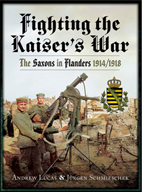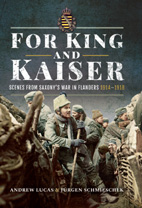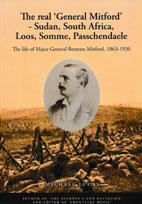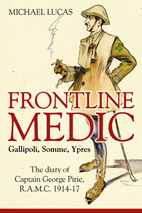This volume is the much-anticipated follow-up to Chris Dale's acclaimed Traditions of the Imperial German Infantry Regiments: their Histories, Uniforms & Pickelhauben (previously reviewed here), which appeared as a print on demand work via Amazon at the height of the pandemic madness in 2021. At the time Chris was already hinting at plans for a second volume devoted to the cavalry. Given the complexity of the multifarious cavalry uniform traditions it was immediately clear that this would be an even more demanding project than the infantry volume, and likely result in a significantly larger book despite covering only half as many units (and a fraction of the manpower). As it turns out the cavalry volume is only slightly larger than its precursor (271 pages versus 254), retaining the same price point and a similar cover design and layout. It has clearly been designed to sit harmoniously alongside the infantry volume on the bookshelf. This greatly appeals to me, as of course does the choice of a Saxon regiment (Kgl. Sächs. 1. Ulanen-Regiment "Kaiser Franz Joseph von Österreich, König von Ungarn" Nr. 17) for the cover!
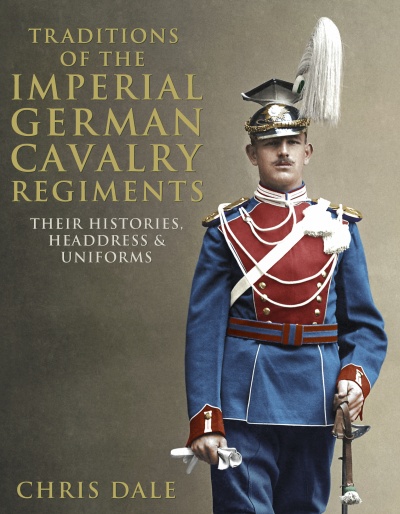
Internally the book also broadly follows the pattern of the infantry volume, but with some significant revisions driven both by the subject matter and doubtless by the benefit of experience. Its scope is similar, covering all units which existed after 1871 in peacetime (including some dissolved / amalgamated prior to 1914) but not those created during the Great War - relatively few in the case of the cavalry. This entirely expected and - for the sake of the author's sanity - understandable omission is mildly frustrating, since (unlike with the infantry) there seems to be no realistic alternative to expensive heavyweight reference works in German should one wish to investigate these often extremely obscure units and their connections to the peacetime active regiments. To give an idea of the scale of this niche subject, Saxony alone mobilised two additional (Reserve) regiments and around a dozen additional independent (Reserve, Landwehr or Landsturm) squadrons in 1914 - all of which broadly followed the uniform traditions of a specific active regiment.
The book opens with a historical overview of German cavalry back to the 17th century, including the specific roles and histories of the different cavalry 'branches' (hussars, uhlans etc.). These distinctions ceased to have any tactical significance by the late 19th century but would continue to dictate uniform tradition until the dissolution of the Kaiserreich. For readers without a detailed knowledge of earlier periods this is highly welcome, as is the succinct and clear explanation of regimental numbering (and its evolution) for readers grounded in a very different system such as the British one. This introductory material is followed by a series of potted histories of the cavalry arm within each of the German states, a very welcome and helpful addition which concentrates information which would otherwise have been scattered by 'branch' throughout the later parts of the book. Considering that many older regiments changed their 'branch' designation repeatedly over the decades and centuries, it is exceptionally useful to be able to find an historical overview of (for instance) the entire Saxon cavalry arm in one place, putting it in the context of the relevant state army.
After covering all of the states (including the very small and obscure ones) the author goes on to address the detrimental effect of increasing firepower on the cavalry's battlefield effectiveness, and its successive concessions to modernity. This includes the reconciliation of Feldgrau with cavalry tradition, which had to be respected if the radical drab uniform were to win institutional acceptance. Not only the 1910 Feldgrau uniform, but also the austere 1915 Feldbluse (which reduced all unit distinctions to shoulderstraps) and elegant 1915 'Friedensuniform' are all covered. The wartime reorganisation and employment of the cavalry are also addressed in general terms, including the sad concept of permanently dismounted Kavallerie-Schützen.
This takes us up to page 57, and the main body of the book. Each cavalry 'branch' is addressed successively under the broader groupings of heavy, medium and light cavalry. There is further subdivision by state contingents, as with the main body of the infantry volume. The various items of dress and accoutrements associated with each branch (and contingent-level variations thereof) are described in detail, including swords, personal equipment and (most usefully for students of the Great War) the Feldgrau version of the uniform. Individual regiments within the branch / contingent are then discussed in detail, each with a short history and a succinct description of their particular variations from the branch / contingent pattern and any special distinctions. The coverage varies from less than a page for some younger regiments to a lavish four-page spread for the famous and highly idiosyncratic Braunschweigisches Husaren-Regiment Nr. 17. Even the pre-war independent Meldereiter-Eskadronen are covered, and their relation to the later Jäger zu Pferde explained.
The book concludes with full-colour plates in the same format as the infantry volume. For each regiment we get a small colour illustration of the 'hard' headgear plus the collar, shoulder, sleeve and cuff of the pre-Feldgrau 'colourful' uniform. This is obviously a less satisfactory approach than it was for the infantry, since (as the main body of the book has explained at length) not only the cloth headgear but also the front and rear of the tunic, the trousers and various additional items of clothing and uniform accoutrements were likewise subject to extensive variation across contingents, 'branches' and individual regiments. However, given the sheer scope of this variation (especially among the hussars), a more comprehensive approach would have drastically enlarged the size of the book beyond all reason. On the other hand, we do get a pair of colour plates showing the lance pennants for every contingent - including the elaborate NCO versions decorated with the state arms.
Like its precursor, this volume is an extremely useful and well-organised reference work. On a very petty note, I should point out that this time around the pages are numbered - and unlike in the more straightforward infantry volume, there is some need for it. Production values are up to the standards set by the first volume, with extensive (but inevitably, not comprehensive) illustrations - both period photos and modern colour shots of relevant militaria. I did find some typos and - at least in the Saxon sections, where the subject matter is most familiar - some small errors (e.g. placing UR 21 on the Western, rather than the Eastern Front in WW1) and omissions (e.g. no mention of the Saxon standard issue of infantry belt buckles to their mounted troops instead of the plain claw buckle used by other contingents). Given the scale of the work and the outrageous complexity of the uniform traditions, this is entirely to be expected and will hopefully be rectified in a subsequent edition. I certainly learned a lot from this volume and will continue to refer to it alongside its 'elder brother'. In all likelihood the author probably does not have plans for an artillery volume (I would not blame him if cataloguing the regalia of the hussars in all its multitudinous complexity has broken his will to live, let alone write), but I for one would eagerly pick up such a work as soon as it appeared...
Buy it here: https://www.amazon.co.uk/Traditions-Imperial-German-Cavalry-Regiments/dp/B0CH2MFBPH/

